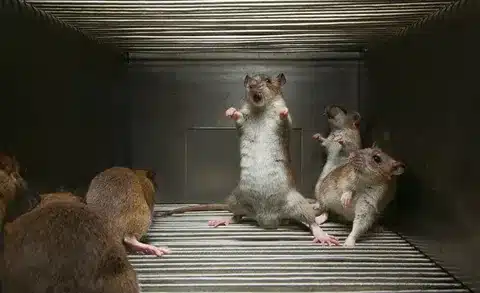Introduction
What Do Rats Sound Like: Rats, despite their diminutive size, possess a surprising array of vocalizations and sounds that can be quite distinctive. These small rodents, commonly found in urban and rural settings worldwide, communicate with one another and their environment through a variety of auditory cues. While many people may associate rats with silence or only the occasional squeak, their vocal repertoire is far more diverse than one might imagine. We will create an intriguing world of rat sounds, shedding light on the fascinating ways these creatures use vocalizations to navigate their complex social lives and express their needs and emotions.
Beyond their reputation as pests or laboratory subjects, rats are highly adaptable and intelligent creatures that rely on auditory communication to coordinate group activities, warn of potential threats, and establish dominance hierarchies. Their vocalizations range from ultrasonic frequencies, imperceptible to the human ear, to more audible chattering, hissing, and squeaking sounds. Understanding what rats sound like is not only essential for pest control but also for gaining insights into their complex social structures and behavior.
We will delve deeper into the different types of sounds rats produce, their meanings in various contexts, and how these vocalizations contribute to the survival and success of this often-misunderstood species. From the eerily quiet moments when they stealthily navigate through our walls to the cacophonous exchanges within their colonies, the sounds of rats reveal a hidden world of communication and adaptation that continues to intrigue researchers and ignite our curiosity about these remarkable creatures.

What kind of noises do rats make?
Whistling or chirping, Rats may make high-pitched whistling or chirping sounds when they are happy or excited. Growling or groaning Rats may growl or grunt when they feel threatened or aggressive. Screaming Rats can make loud, high-pitched screams when they are in extreme distress or pain.
Chirping or Whistling: Rats can emit high-pitched chirping or whistling sounds when they are happy or excited. These noises are often associated with playfulness or contentment.
Growling or Groaning: When rats feel threatened, territorial, or aggressive, they may emit growling or groaning sounds. These low-pitched vocalizations serve as warnings to other rats to stay away or back off.
Screaming: Rats can produce loud, high-pitched screams when they are in extreme distress or pain. These screams are distress calls and typically indicate a severe threat or injury. It’s essential to respond quickly when you hear a rat screaming to address the underlying issue, whether it’s a medical emergency or a predatory threat.
Chattering: Rats may produce rapid chattering sounds, often described as teeth grinding or clattering. This noise can signify excitement or anticipation, such as when they are about to receive food or interact with other rats.
Hissing: Hissing sounds are another defensive vocalization used by rats. When they feel cornered or threatened, rats may hiss to deter potential threats and communicate their discomfort.
Purring: Rats can also purr, which is typically a sign of relaxation and contentment. Purring is often heard when rats are being petted or are in a comfortable and secure environment.
Are rats noisy at night?
Rats are nocturnal animals, so you’ll often hear them during the night. Rats will make chattering, squeaking, scattering and hissing sounds to communicate to others in their colony. Rats like to move around the same areas, which is why you will hear these sounds in one area of your home.
Rats are indeed nocturnal creatures, which means they are most active during the night. Their activity patterns are adapted to the darkness, which provides them with cover and safety from potential predators. It’s common to hear rats making various noises during the night.
Rats communicate with each other using a range of vocalizations, including chattering, squeaking, and hissing. These noises serve various purposes within their colonies, such as coordinating activities, establishing dominance hierarchies, and signaling potential threats. Rats are known for their gnawing and scratching behaviors, which can create sounds as they navigate through their environment.
If you hear these noises coming from within your home, it’s a sign that you may have a rat infestation. To address the issue promptly, as rats can cause damage to your property and pose health risks. Seeking professional pest control assistance is often the best way to manage and eliminate a rat infestation.
Do rats come out when there is noise?
Rats and rodents in general are very sensitive to sound, since it’s one of their main tools for survival. Any new or unexpected noise will frighten them and send them scurrying.
Rats are indeed sensitive to sound, and sudden or loud noises can startle them. That rats are nocturnal animals, which means they are naturally more active during the night when the environment is typically quieter. They have evolved to be cautious and stealthy when foraging for food or exploring their surroundings.
While rats may be initially scared by loud or unexpected noises, they can become habituated to consistent or constant background noises. In urban environments, they may become accustomed to the sounds of traffic, construction, or other human activities and continue their routines despite the noise.
Rats’ sensitivity to sound can vary based on their individual experiences and the level of noise regularly. In some cases, loud noises may deter rats temporarily, but they may return to their usual activities when they perceive the environment as safe. Effective rat control typically involves a combination of strategies, including addressing factors that attract rats to an area and implementing measures to prevent their access and remove food sources.
Can humans hear rats squeak?
Rats make noises like squeaks, chirps, and hisses. They can communicate different emotions depending on the frequency of the noise Opens in a new window. Often, squeaks or hisses signify that a rat is afraid or in pain. Almost all rat vocalizations are undetectable by the human ear because they are ultrasonic.
It is not entirely accurate to say that almost all rat vocalizations are undetectable by the human ear because they are ultrasonic. While it is true that rats can produce ultrasonic vocalizations, they also emit audible sounds that are within the range of human hearing.
Rats are capable of producing both audible and ultrasonic vocalizations. The ultrasonic vocalizations, which are at frequencies above the range of human hearing (typically above 20,000 Hertz), are often used for communication within their own species. These ultrasonic sounds are used for various purposes, including social interaction and courtship, which humans cannot perceive without specialized equipment.
Rats also produce audible sounds that fall within the range of human hearing. These include the squeaks, chirps, and hisses you mentioned. These audible sounds can convey emotions like fear, distress, or pain and are used for communication in their interactions with other rats and with their environment. Humans can hear these audible rat vocalizations, especially when they are in close proximity to the source of the sound.
What do rats sound like compared to mice?
Rats make hissing, chattering and squeaking noises to express happiness, fear and pain. Mice are more likely to make high-pitched squeaks to communicate with one another. A mouse travels in an area between 10 to 30 feet in diameter to look for food and water.
Rats
- Rats are known to make a variety of vocalizations, including hissing, chattering, and squeaking. These sounds can express a range of emotions, including happiness, fear, and pain.
- Rats are larger than mice, and their vocalizations are often deeper and more resonant than those of mice.
- Rats are generally more social animals, and they may communicate with each other through a broader range of vocal cues and body language.
Mice
- Mice, on the other hand, are more likely to emit high-pitched squeaks to communicate with each other. These squeaks can convey various messages, such as alarm, mating calls, or distress.
- Mice are smaller than rats, and their vocalizations tend to be higher-pitched and less varied compared to rats.
- Mice are known for their curiosity and agility. They tend to explore smaller areas, typically within a range of a few feet, while searching for food and water.
Can you hear rats scratching?
The sound is particularly noticeable at night. Rodents are more likely to be active at this time because there’s less chance of humans being around. You may notice droppings around your home.
Scratching: Rats have sharp claws, and when they move around or climb, they can produce scratching sounds. These sounds can be quite noticeable, especially if rats are moving in wall voids or ceilings.
Gnawing: Rats have a constant need to gnaw on objects to keep their teeth from growing too long. This gnawing behavior can produce distinct and persistent sounds as they chew through materials like wood, plastic, or electrical wiring.
Scurrying: Rats are agile and can move quickly. Their rapid movements can create scurrying or rustling sounds as they navigate through tight spaces.
Droppings: As you mentioned, another sign of rat activity is the presence of droppings. You may find rat droppings in areas where they are active, which can help confirm their presence.
If you hear scratching or gnawing sounds in your home, particularly at night, it’s a strong indicator of a possible rat infestation. It’s crucial to address this issue promptly to prevent further damage to your property and to address any potential health risks associated with rats. Seeking professional pest control assistance is often the best course of action to identify and eliminate the infestation.
How do you get rid of rats with sound?
When it comes to rodent removal, one of the most natural ways to get rid of mice and rats is to place an ultrasonic repellent unit. Ultrasonic pest control products from Victor use high frequency sound waves to drive away mice and rats by creating an unpleasant environment for them.
Effectiveness Varies: The effectiveness of ultrasonic repellent devices can vary widely. Some users report success in deterring rodents, while others see no noticeable impact. Factors such as the type of device, the specific pest species, and the environment can influence their success.
Limited Range: Ultrasonic waves have a limited range and can be blocked or absorbed by walls, furniture, and other objects. This means you may need multiple devices to cover larger areas effectively.
Adaptation: Rodents can become accustomed to constant or repetitive sounds, including ultrasonic waves, and may eventually ignore them.
Not a Guarantee: Ultrasonic repellent devices are not a guaranteed solution for rodent control. They are best used as part of an integrated pest management plan that includes other strategies such as sealing entry points, removing food sources, and using traps.
Can you hear rats walking?
Rats tend to move pretty quickly so you’re likely to hear scurrying noises. Like any pest, they like to keep well-hidden so it’s unlikely they’ll directly cross your path. While this may be a relief, it can also make them difficult to detect.
That rats tend to move quickly and are often heard making scurrying noises rather than the sound of their footsteps. Their rapid movements can create a rustling or scuttling sound as they move through wall voids, ceilings, or other hidden spaces. Rats are generally cautious and try to remain concealed, which can make it challenging to directly observe their movements.
These scurrying noises are a common indicator of rat activity in a building. If you hear such sounds, it’s essential to investigate further to determine the extent of the infestation and take appropriate measures for rat removal and control. The presence of rat droppings, gnaw marks on objects, and other signs can help confirm the presence of rats in your home or property.

Conclusion
The sounds of rats offer a captivating glimpse into the intricate lives of these highly adaptable rodents. Beyond their reputation as nuisances or subjects of scientific study, rats employ a rich tapestry of vocalizations to convey essential information, establish social hierarchies, and navigate their environments. From the subtle chirps of contentment to the urgent warnings of danger, these sounds serve as a vital means of communication for these often misunderstood creatures.
Rat sounds like not only aids in pest control efforts but also enhances our appreciation for the complexity of their behavior and social structures. It reminds us that even in the hidden corners of our urban landscapes, there exists a thriving world of communication, adaptation, and survival. To study and decode the language of rats, we uncover a wealth of knowledge that fosters a deeper connection with the natural world and invites us to reconsider our perceptions of these remarkable animals.
The study of rat vocalizations holds practical implications for various fields. Researchers and pest control experts can use this knowledge to develop more effective strategies for managing rat populations, potentially reducing the need for harmful pesticides or inhumane trapping methods. By deciphering the meanings behind rat sounds, we can better understand their behaviors.





No Comments